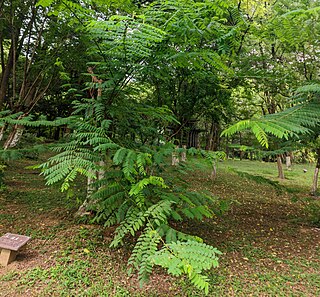
Primula is a genus of herbaceous flowering plants in the family Primulaceae. They include the primrose, a familiar wildflower of banks and verges. Other common species are P. auricula (auricula), P. veris (cowslip), and P. elatior (oxlip). These species and many others are valued for their ornamental flowers. They have been extensively cultivated and hybridised. Primula are native to the temperate Northern Hemisphere, south into tropical mountains in Ethiopia, Indonesia, and New Guinea, and in temperate southern South America. Almost half of the known species are from the Himalayas.

Erythrophleum fordii is a species of plant in the family Fabaceae. It is a tree about 10 metres (33 ft) tall, occasionally reaching 30 metres. It is found in southeastern China, Taiwan, and Vietnam. It is a valuable timber tree threatened by overexploitation. It is under second-class national protection in China.
Ormosia hosiei is a species of flowering plant in the family Fabaceae.

Zenia is a genus of plants in the family Fabaceae. It belongs to the subfamily Dialioideae. It contains a single species, Zenia insignis. It is a medium-sized tree, 15–20 metres (49–66 ft) tall. It is found in southern China and northern Vietnam. It is threatened by habitat loss and overharvesting. The species is under second-class national protection in China.
Castanopsis scortechinii is a species of plant in the family Fagaceae. It is a tree endemic to Peninsular Malaysia. It is threatened by habitat loss.
Gmelina hainanensis is a species of tree in the family Lamiaceae. It is a medium-sized tree, up to 15 metres (49 ft) tall, growing on open grassy hillsides and sparse forests. It is found in southern China and in Vietnam.

Helicia is a genus of 110 species of trees and shrubs, constituting part of the plant family Proteaceae. They grow naturally in rainforests throughout tropical South and Southeast Asia, including India, Sri Lanka, Indochina, Peninsular Malaysia to New Guinea and as far south as New South Wales.
Hopea chinensis is a species of medium-sized tree in the family Dipterocarpaceae. It is found in China and northern Vietnam.

Parashorea chinensis is a large species of tree in the family Dipterocarpaceae. It is native to southern China and in northern Laos and Vietnam. It is threatened by habitat loss. The species is under first-class national protection in China.
Aralia castanopsicola, synonym Pentapanax castanopsicola, is a species of plant in the family Araliaceae. It is endemic to Taiwan. It is threatened by habitat loss. The specific epithet is spelt in various ways, including castanopsidicola.
Phoebe bournei is a species of tree up to 20 metres (66 ft) tall in the family Lauraceae. It is endemic to China, where it occurs in Fujian, Guangdong, Guangxi, Guizhou, Hainan, Hubei, and Jiangxi provinces. It is threatened by habitat loss. The species is under second-class national protection in China.
Phoebe chekiangensis is a species of tree up to 20 metres (66 ft) in the family Lauraceae. It is endemic to China where it occurs in Fujian, Jiangxi, and Zhejiang provinces. Its name refers to Zhejiang province that is written "Chekiang" in Wade–Giles romanization. It is threatened by habitat loss. It is under second-class national protection in China.

Phoebe zhennan is a large species of tree, up to 30 metres (98 ft) tall, in the genus Phoebe of the family Lauraceae. The name "Zhennan" is the transcription of one of the tree's Chinese names, 楨楠/桢楠. It is endemic to China, where it occurs in Guizhou, Hubei, and Sichuan provinces. The species is threatened by habitat loss, and so is under second-class national protection in China. In the past, wood from this tree, referred to as nanmu in China, was so valuable that only royal families could afford their use. Notably, whole logs of Phoebe zhennan wood were used to create pillars for the Forbidden City.

Hydnocarpus annamensis is a tree in the Achariaceae family. It is found in Thailand, Cambodia, Vietnam, southern Yunnan and southern Guangxi in Zhōngguó/China. It is threatened by habitat loss. The plant produces low-quality wood and its fruits are used in traditional medicine.

Quercus myrsinifolia is an Asian species of tree in the beech family Fagaceae. It has several common names, including bamboo-leaf oak, Chinese evergreen oak, and Chinese ring-cupped oak. Its Chinese name is 小叶青冈; pinyin: xiǎo yè qīng gāng, which means little leaf ring-cupped oak, in Japan it is called white oak and in Korea it is known as gasinamu (가시나무). It is native to east central and southeast China, Japan, Korea, Laos, northern Thailand, and Vietnam. It is placed in subgenus Cerris, section Cyclobalanopsis.
Deutzianthus tonkinensis is a species of small tree up to 12 metres (39 ft) tall in the family Euphorbiaceae. It is found in southern China and northern Vietnam. The species is under second-class national protection in China.
Castanopsis clemensii is a tree in the family Fagaceae. It is named for the American chaplain and plant collector Joseph Clemens.

Castanopsis javanica, the Javan chestnut-oak, is a tree in the beech family Fagaceae. The specific epithet javanica is from the Latin, meaning "of Java".
Castanopsis pedunculata is a tree in the family Fagaceae. The specific epithet pedunculata means 'having a peduncle'.

Castanopsis indica is a tree in the family Fagaceae.











